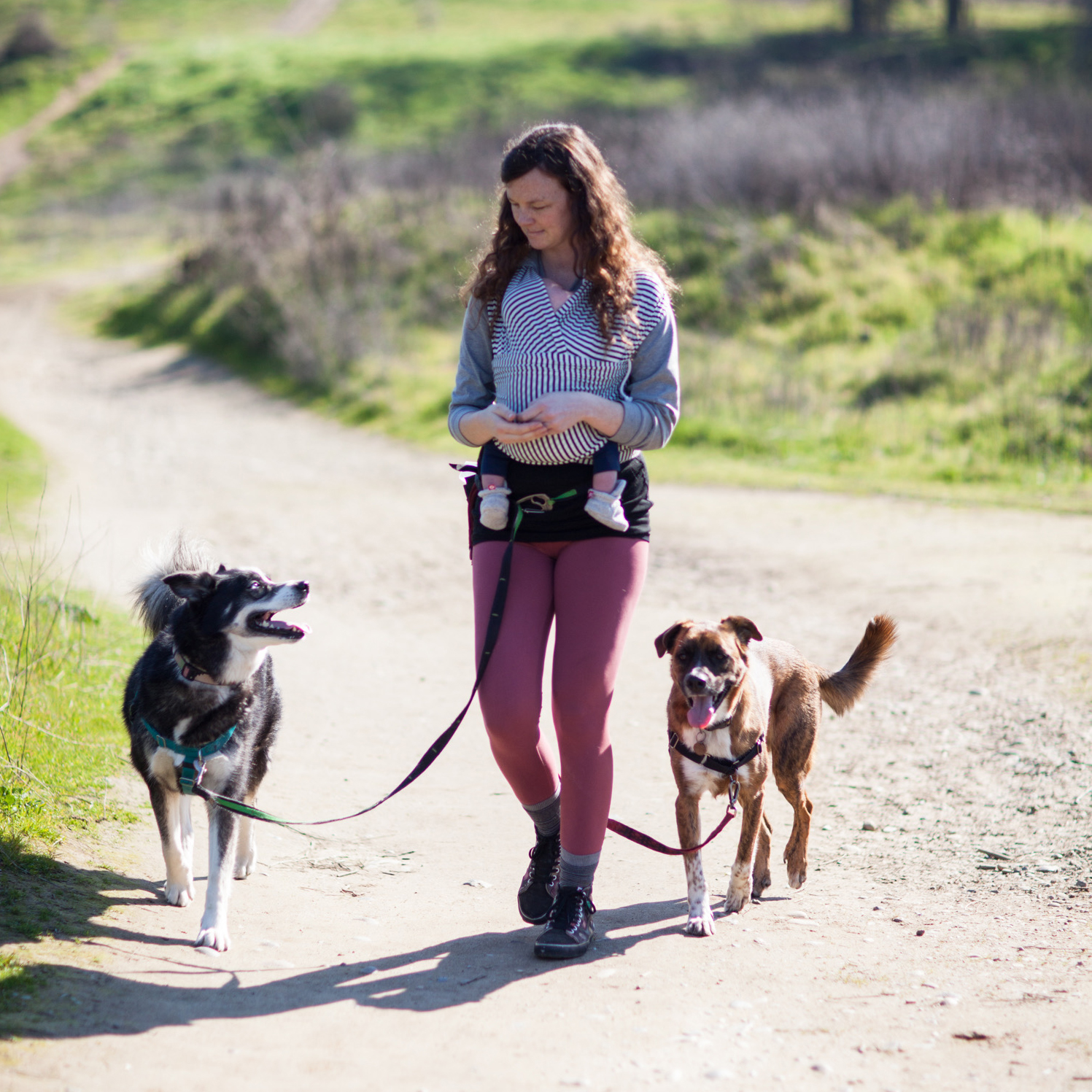“Reactive” has become something of a buzzword of late.
Let’s dive in to what it means to have a “reactive” dog, and how you can best understand your dog's body language to support your dog.
Many pet parents aren't sure how to know the difference between an excited dog or a frightened dog or a dog who is showing actual aggressive behavior. It's important to be able to tell what's behind your dog's reactive behavior so you can support your dog in ways that match the cause.
Dogs communicate their feelings through body language and behavior, which is why the more in tune you are with your dog and skillful about reading dog body language, the better you'll be at helping your dog feel comfortable in the world.
What is "reactive" dog body language & behavior?
First of all - when we say “reactive,” we usually mean a dog who growls, lunges, or generally overreacts to stimuli like other dogs, strange people, cars, bicycles, scooters, other animals, etc. The scope of what a dog reacts to and how a dog reacts is VERY broad. And when it comes down to it, all dogs react to some stuff - a dog who doesn’t react to anything is, well, not a real, living, breathing dog.
I believe the term "reactive" has been widely used because it does cover a range of behaviors and we all want to avoid describing our dogs too narrowly or incorrectly as an "aggressive dog." But from a behavioral/reactive dog training standpoint, the word doesn’t convey a whole lot of useful information. When I'm contacted by "reactive dog" owners about their dog, my response as a dog trainer tends to consist of approximately one thousand follow-up questions.
So, moving to a more practical discussion - how can we best support the many dogs who have come to be called reactive?
Your Dog's Plan
Stop! Don't read this long article. Instead, get everything you need to know, including all advice on Understanding Reactivity, in a customizable step-by-step plan for your dog created by our community of certified trainers and nutritionists.
The first step is to observe your dog’s behavior.
It’s actually helpful to keep a written log, observing each and every situation in which reactive responses occur to get to know your dog's triggers.
6 things to note when logging your reactive dog's behavior:
1) What seemingly caused the reactive behavior
Was it a particular person, dog, loud noise, etc? Note your dog's environment the behavior occurred in as well. This is known as your dog's trigger.
2) Where that trigger was in relation to your dog
Both in terms of distance from your dog, as well as movement in relation to your dog (i.e. 20 feet away and moving away or across the street moving toward you).
3) Time of day and location
Was it on a narrow sidewalk, near a dog park with dogs in view, close to a bike path, after school, rush hours, etc. Also to note - whether your dog was on or off leash; many leash-reactive dogs can show leash reactivity behaviors around other dogs on leash but are totally fine with other dogs off leash at home/in their yard, for example.
4) Body language observations both leading up to as well as during the reaction
This is where knowing canine body language matters. Canine communication is about so much more than just your dog's tail position (a wagging tail doesn't always mean a happy dog!). You'll want to note everything your dog does and when, some things obvious, some nuanced.
Some examples of body language to note:
- Stopped when he/she observed another dog
- Changed body posture - body stiffened, tail lowered
- Your dog's ears became pinned back
- Your dog's eyes got the "whale-eye" look (when you see more whites of eyes)
- Started lip-licking
- Lifted paw, sniffed the ground, and/or lunged toward other dog
- Crouched or "became small" (maybe in what looked like a play bow but was actually a fearful dog reaction)
- Barked excessively (an obvious one)
The more specific you can be about what your dog's body is actually doing the better. Avoid simply using terms like “reacted” or “freaked out.” What did you see with your eyes?
5) Notes about recovery
Did your dog show relaxed body language shortly thereafter or did he/she remain tense? Was your dog able to resume what he/she was doing prior to the reaction? Did your dog move toward or away from the trigger as you continued on?
6) Background information from the day
Background includes context such as other encounters earlier with triggers, playdates, other dog owners and their dogs, illnesses or injuries, stressful incidents whether or not they elicited a similar reaction.
The more specific you can be in making these observations, the more accurately you’ll be able to predict triggers and your dog's emotional state, and therefore begin reactivity training.
Understanding Reactivity
Interested in Understanding Reactivity? Follow topics you're interested in to customize your dog’s step-by-step plan so it's most helpful and tailored to your dog when you're ready to get started.
Your next step - setting your reactive dog up for success
The first, best way to help your dog work toward reducing big explosive reactions and unwanted behavior is to avoid those triggers at all costs.
Try this
Manage your dog’s environment so that he or she is not exposed to the things that make him go bonkers. Use what you learned in your note-taking to plan less stressful, "under-threshold" routes and activities when you and your dog are out and about.
People hate this step. We love our neighborhood walks, our routines, and our ideas of who our dogs should be and how they should cope with certain stimuli. But if our dogs are reacting in these over the top and embarrassing ways, we are getting important information about what they are capable of right now. It’s our job to set them up for success.
Let's practice
Take your observations and translate them into action. You know your dog's triggers, you've noted observations about his/her reactions, and made efforts to manage your dog's environment.
Now let's delve deeper into the practicalities of implementing reactivity training.
1) How can you avoid triggers?
Avoiding the trigger simply means staying away from the thing that causes your dog to react (like another dog). This could mean crossing the street, turning and going a different route, or leaving the area altogether.
2) What should you look for in a "safe" space for your dog?
A safe space for your dog could be a secluded area where there are no triggers in sight, or it could be a distance from the trigger that keeps your dog calm and able to focus on you. It should also have enough room for you and your dog to comfortably move around.
3) What are some techniques you can use to get your dog to focus on you?
Some techniques include using high-value dog treats, practicing obedience commands, and engaging in fun games or activities with your dog. The key is to redirect your dog's attention away from the trigger and onto you.
Remember, every dog is different and what works for some reactive dogs may not work for others. Be patient and consistent in your training methods and always consult with a professional dog trainer if you need additional guidance.
Reactivity
Need more advice? Browse all guides in the Reactivity Channel on topics like Managing Reactivity, Reactivity Training, Leash Reactivity, and Understanding Reactivity - created by our community of certified experts for you and your dog.
Why managing your dog's environment is so much more than avoidance
Managing the environment so reactive dogs aren’t exposed to triggering encounters is more than just avoiding the issue, it’s also letting our dogs know that as their partner, we have their back, and we won’t put them into situations they can’t handle.
If you have an adult reactive dog, your pup may have years of experience with stress and fearfulness triggers to unlearn so changing the environment gives your adult dog the safe space to learn it's all good with you.
Give your dog a break from stress & make learning possible.
It’s also giving your dog a break from the stress hormones that flood their brain during a big reaction, which can take a long time to dissipate from their system. Plus, it is pretty much impossible to teach dogs new behaviors when they are continually practicing the old behaviors we want to avoid.
If dogs are rehearsing these undesirable behaviors often, you're not going to see any progress. Skip the dog parks, for an obvious example, and you'll want to think about avoiding any places where you know your dog will be uncomfortable and stressed and where no learning can happen.
This is a big step, I know, and it often involves rethinking key aspects of life. But it makes a huge difference, and once you take this step, you can begin to move onto other ways of helping your reactive dog be more confident and comfortable in the world, and begin to behave in ways we appreciate more with calm behavior!
Next up in the Reactivity Channel on Dogly
Once you have a good understanding of your dog's triggers and what it means to have a reactive dog, you can begin to support your dog by anticipating and managing potentially stressful scenarios. Check out the next guide to learn how to positively focus your feelings as well as your dog's and how to use counter-conditioning behavior modification to change how your dog feels around triggers to become a calmer, happier dog out in the world with you.
If you have any questions on reactivity and your dog, just ask us in our Community Discussion. Or continue in our Reactivity Channel where you'll learn everything you need to know for your dog from our community of Dogly Training Advocates.
If you ever need more personalized dog training tips, get started in your dog's training plan here.

